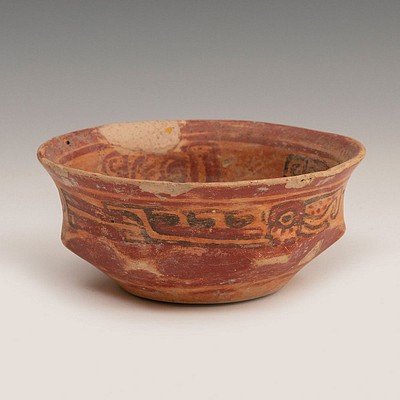Skyphos. Gnathia century, IV BC. Black glazed ceramic.
Lot 108
About Seller
Setdart Auction House
Carrer Aragó 346
Barcelona
Spain
Setdart Subastas was born in 2004 and is currently the first online art auction in Spain with solidity, prestige and reliability guaranteed by our more than 60,000 users. Setdart has a young, dynamic and enterprising team ready to successfully manage the purchase and sale of art works through custom...Read more
Categories
Estimate:
EUR€250 - EUR€300
$260.42 - $312.50
Absentee vs Live bid
Two ways to bid:
- Leave a max absentee bid and the platform will bid on your behalf up to your maximum bid during the live auction.
- Bid live during the auction and your bids will be submitted real-time to the auctioneer.
Bid Increments
| Price | Bid Increment |
|---|---|
| EUR€0 | EUR€10 |
| EUR€200 | EUR€25 |
| EUR€500 | EUR€50 |
| EUR€1,000 | EUR€100 |
| EUR€3,000 | EUR€200 |
| EUR€5,000 | EUR€500 |
| EUR€10,000 | EUR€1,000 |
| EUR€20,000 | EUR€2,000 |
| EUR€50,000 | EUR€5,000 |
About Auction
By Setdart Auction House
Dec 23, 2021
Set Reminder
2021-12-23 04:30:00
2021-12-23 04:30:00
America/New_York
Bidsquare
Bidsquare : Archaeology, Session II
https://www.bidsquare.com/auctions/setdart-auction-house/archaeology-session-ii-8051
Setdart Auction House sofia@setdart.com
Setdart Auction House sofia@setdart.com
- Lot Description
Skyphos. Gnathia century, IV BC. Black glazed ceramic. Measurements: 8 x 9,5 cm. Skyphos made in the workshops of Gnathia, decorated with the black glaze technique, combined with synthesized geometric and vegetal motifs brushed in red and white colors, organized in concentric bands, following a typical style of Gnathian pottery. The skyphos is a deep wine cup, with two handles and a low, wide base, or without a base. The handles may be small and horizontal, projecting from the rim (in Corinthian and Athenian forms), or they may be loop-shaped, set on the rim or protruding from the base. The black glaze technique employs the same glaze used on the red and black-figure ceramics, but covering the piece completely, without figurative decoration. It was a transparent raw glaze, which adopted its characteristic black tone, intense and shiny, once fired. Gnathia vases are a type of pottery belonging to ancient Apulian painting from the 4th century B.C. They owe their name to the ancient city of Gnathia (now Egnazia) in eastern Apulia. There, the first examples of the style were discovered in the mid-19th century. Its production began in Apulia around 370/360 BC, paralleling the local version of the red-figure style that developed trends toward polychromy at that time. Gnathia vases are characterized by the application of different paints directly on the body of the vase. The subjects depicted include erotes, images of women's lives, theatrical scenes and Dionysian motifs. Painting was often limited to the upper half of the vase body, while the lower half often had only ornamental decoration. The most common forms were bells, pelicans, oinochoai and skyphos.
- Shipping Info
-
In-house shipping available. Please inquire at admin@setdart.com.
-
- Buyer's Premium



 EUR
EUR CAD
CAD AUD
AUD GBP
GBP MXN
MXN HKD
HKD CNY
CNY MYR
MYR SEK
SEK SGD
SGD CHF
CHF THB
THB














